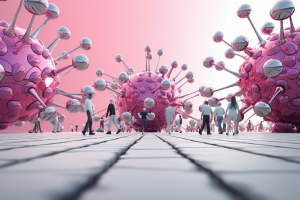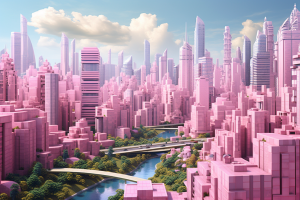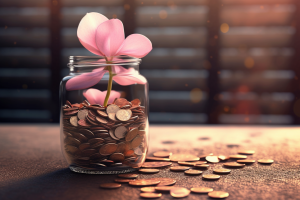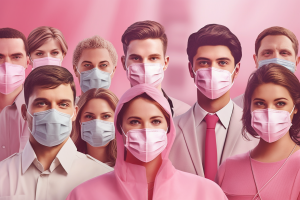Article-at-a-glance:
– Content marketing thrives with a 16.37% Compound Annual Growth Rate (CAGR) expected (2022-2027), as 71% of marketers recognize its growing importance for brand storytelling.
– Success hinges on a well-crafted strategy focusing on audience personalization, with a trend towards interactive content, valuing quality over quantity.
– Explore statistics, trends, and benchmarks that you can use for better content marketing activities in 2025.
Content marketing’s pulse is stronger than ever.
Consider this: in the past year alone, a whopping 71% of marketers emphasized its heightened significance to their brands. And why not? It’s the driving force behind digital narratives, shaping brand stories, and sculpting customer journeys.
We have compiled essential content marketing statistics, benchmarks, and trends from leading sources to ensure that your marketing efforts in 2025 hit the goals.
Content Marketing Usage Statistics
The content marketing market size is estimated to grow at a CAGR of 16.37% between 2022 and 2027. Finding success here means adopting and using content marketing as part of a holistic marketing program.
- The content marketing market is expected to be over USD 564.8 billion in 2025 and reach $1.95 trillion by 2032. [Research Dive]
- 93% of B2B marketers and 86% of B2C marketers use content marketing. [Demand Metric]
- 47% of B2B content marketers say that having a documented content strategy contribute to their content marketing success. [CMI]
Content Marketing Strategy Statistics
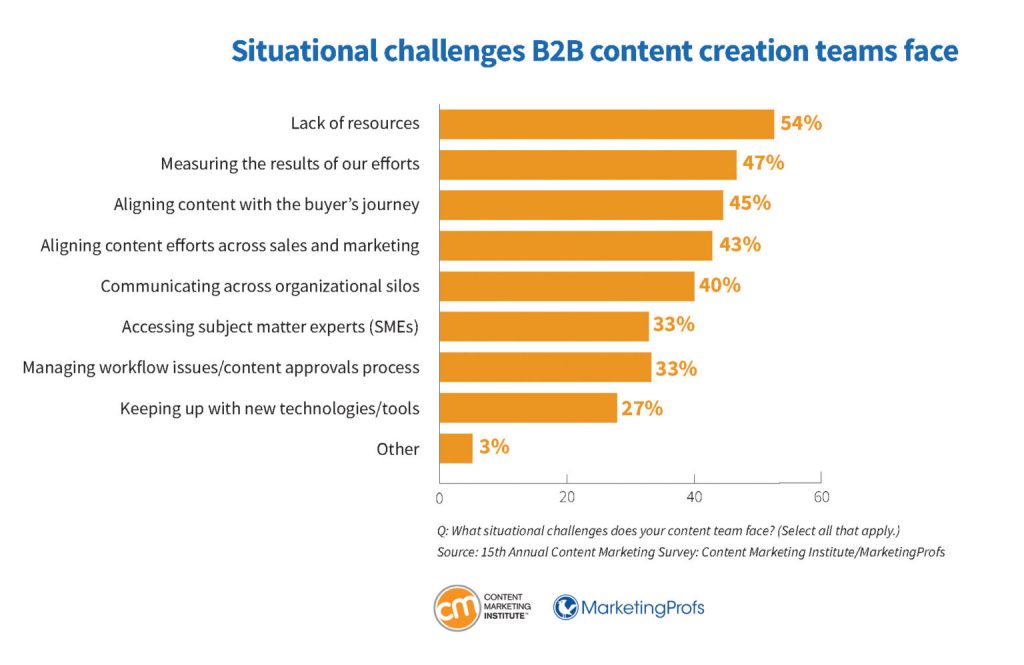
So, to overcome the challenges and be truly successful at content marketing, having the right strategy is critical. But how to create the right content marketing strategy? Here’s what the marketers are saying.
- 95% of B2B content marketers have a documented content strategy and out of that, about 58% say that it’s moderately effective. [CMI]
- Personalization and hyper-segmentation are expected to dominate the content marketing scene. [Kellie Davis on LinkedIn]
- Whether you’re in the B2B or B2C sector, it’s important to humanize your content and storytelling since marketing is all about Business-to-Human (B2H). [Similarweb]
- Interactive content, such as quizzes, embedded links, ROI calculators, and demos, is becoming increasingly popular. [Demand Gen Report]
- Which is more important: Content quantity vs. quality?

Content Budget Statistics
Budgets are the backbone of any content marketing strategy, and understanding how funds are allocated can offer insights into priorities and future trends. Here’s how organizations are channeling their resources towards content marketing.
- 63% of marketers say that they’re aware of their organization’s content marketing budget. [CMI]
- 46% of marketers believe that their content marketing budget will increase in 2025. [CMI]
- 61% B2B marketers say they would increase their spending on video, followed by thought leadership content (52%), and AI for content optimization/performance (40%). [CMI]

Content Audit Statistics
Content audit: essential, yet often overlooked. It’s the key to gauging your content’s effectiveness and planning ahead for better results. With the right approach, it’s not daunting, but enlightening. Here are some trends and benchmarks for content audits.
- 61% of successful marketers conduct content audits two or more times a year. [Semrush]
- Most marketers consider on-page, off-page, and technical SEO when conducting a content audit. [Databox]
- 53% of marketers say updating their content helped increase engagement while 49% saw an increase in traffic and/or rankings. [Semrush]
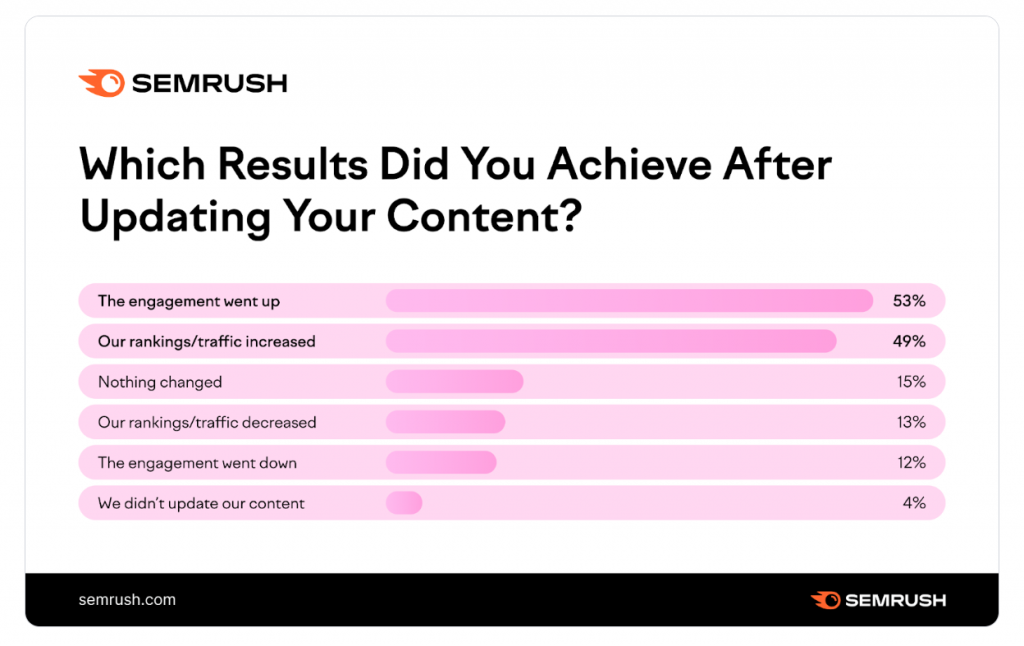
Content Team Statistics
People, process, and technology. These are the 3 elements that can successfully drive action, in our case: creating engaging content. Let’s see what’s in store for content teams in 2025.
- 35% of businesses lack specialized content marketing teams. [DemandSage]
- In light of recent layoffs and budget cuts, companies are leaning towards freelancers and fractional CMOs for cost efficiency, realizing the competitive edge they bring. Content marketers should leverage them to conveniently scale content creation and with on-demand creative talent. [HubSpot]
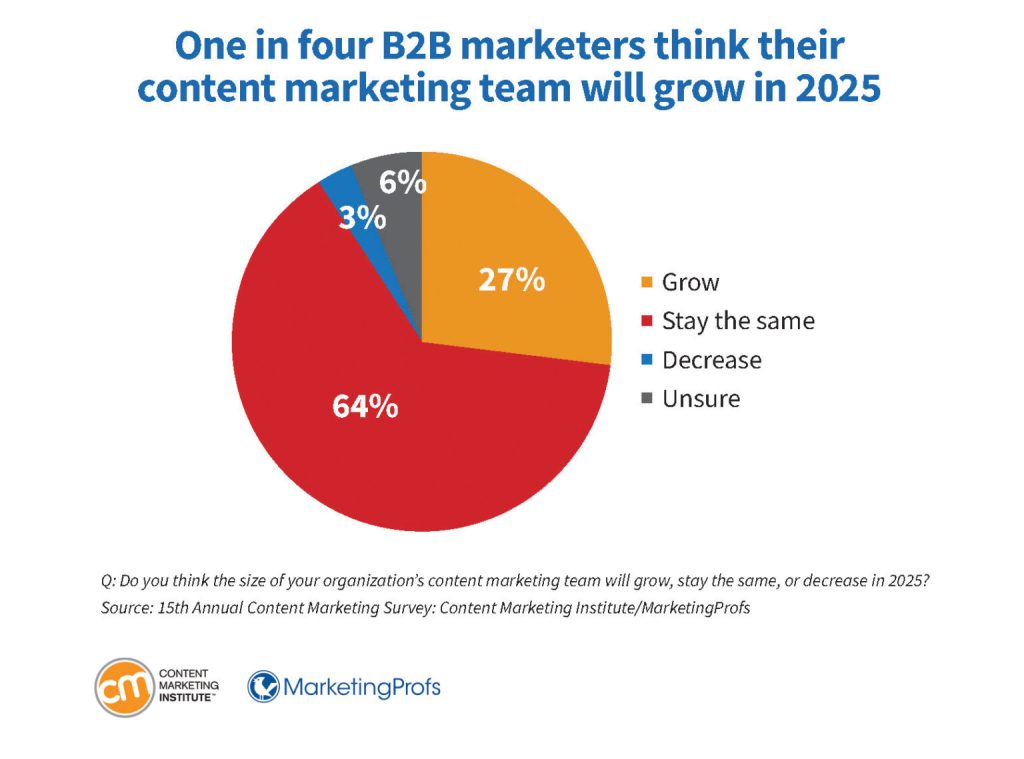
Content Production Statistics
To consistently produce high-quality content, you must have a team of all-stars and a solid content production process in place.
- 24% of marketers say that they don’t have dedicated content marketing teams or staff. So, to produce content, they rely on multiple content teams (50%) and third-party content marketing agency/vendor (7%). [CMI]
- 45% of marketers also don’t have a scalable model for content creation. [CMI]

Content Tools Statistics
Coupled with powerful tools and technology, content teams can take their content marketing activities to the next level.
- 38% of marketers say that they have the right content management technology but they’re not using to its potential. So, dedicating some time to get the most out of the content tool can be a quick way to increase ROI. [CMI]
Content Format Statistics
You have your team, your processes, and tools. So, what kind of content should you prioritize in 2025 and beyond?

Content – Blogging Statistics
Content marketing used to be synonymous with blogging, but not anymore. Nevertheless, it’s still an important piece of content to create as part of your marketing strategy.
- As of 2023, there are over 600 million blogs online out of 1.9 billion websites worldwide. [Web Tribunal]
- 90% of content marketers leverage websites and blogs the most in their content strategy. [Seige Media & Clearscope]
- Content marketers who blog are 13 times more likely to see a positive ROI than those who don’t. [HubSpot]
- How-to articles are the most popular content for bloggers to write. [WPBeginner]
- People are far more likely to scan than read word for word. At most, they read about 28% of the words on the average web page; 20% is more likely. [Neilsen]
- Posts over 3000 words get 77.2% more referring domain backlinks than content shorter than 1000 words. [Backlinko]
Content – Video Statistics
According to Sprout Social, more than half of marketers say video is the most valuable type of content. And with people watching more videos now than they ever have before, video content is no longer nice-to-have; it’s a must. Here are some essential video content marketing statistics you should know for 2025:
- Videos will account for a whopping 82% of all consumer internet traffic by 2025, while video streaming will make up 91% of global internet traffic. [Integral Ad Science]
- 58% of marketers say that videos deliver some of their best results – followed by case studies/customer stories (53%) and e-books/white papers (45%). [CMI]
- 40% of marketers said creating more visual, and video content improved their content marketing. [Semrush]
- 97% of marketers said that video helped increase user understanding of their product or service, while 76% said that it helped them increase sales and revenue. [HubSpot]
- Short-form, vertical videos will continue to reign supreme in 2025, with platforms like TikTok, Instagram Reels, and YouTube Shorts leading the charge. [Wordstream]
- Users who watch videos without sound have been increasing; hence, adding captions with “searchable keywords and industry terminology” is necessary. [SocialInsider]
- Expect to see even more AI tools to hit the market – making it easier for marketers to generate videos. [Wordstream]
Content – Podcast Statistics
By 2025, there will be over 114 million U.S. podcast listeners, which demonstrates the tremendous growth that podcasting has experienced. Before you create podcast content as part of your marketing efforts, check out the crucial trends and statistics below.
- The US podcast ad revenue is expected to reach $2.38 billion in 2025. [Oberlo]
- Marketers in the US are projected to spend up to $2.379 billion on podcast ads in 2025. [Marketing Charts]
- 82% of marketers plan on investing the same or more into podcasts or other audio content moving forward. [HubSpot]
- B2B content marketers spend about 4.8 hours to create a podcast episode. [Casted]
Content Distribution Statistics
Content is king, but distribution is queen and she wears the pants.
Jonathan Perelman of BuzzFeed
- 89% of marketers use social media platforms (organic), followed by blogs (84%), and email newsletters (71%) to distribute content. [CMI]
- Just like last year, more than half of surveyed marketers said that in-person events and webinars are the best distribution channels to get results. [CMI]
- When it comes to paid content distribution channels, 73% use social media advertising/promoted posts. [CMI]
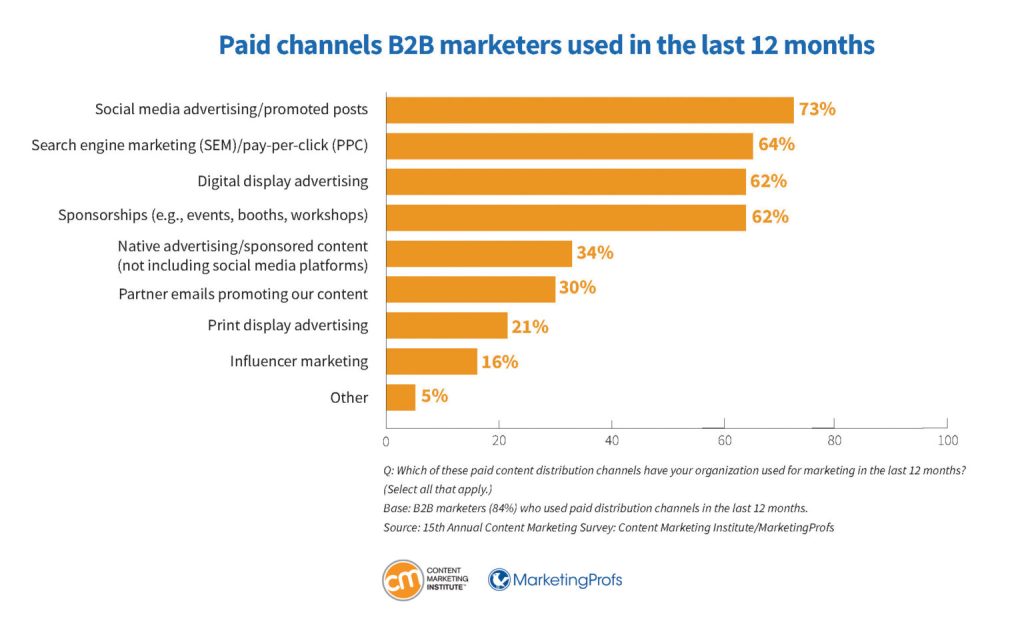
Content Performance Statistics
Creating content alone isn’t enough; you must regularly measure their performance too. This way, you can iterate on your content marketing campaigns and improve their success rate. But one thing is certain when it comes to content marketing ROI: more resources invested in content marketing leads to stronger results over time.
- 72% of the successful marketers measure the ROI of their content marketing. [Insider Intelligence].
- 51% of B2B marketers agree their organization measures content performance effectively. [CMI]
- Content marketing costs 62% less than outbound marketing and provides 3x better lead generation. [Demand Metric]
- 22% of B2B marketers say that their content marketing is extremely or very successful. These top-performers are more likely to: [CMI]
- Think that their team size will grow in 2025.
- Rate their content strategy as successful.
- Have the right technology to manage content across the organization.
- Have a scalable content creation model – and this model can create the desired outcome.
- Measure content performance effectively.
- Use content successfully to generate demand/leads, nurture subscribers/audiences/leads, grow loyalty with existing clients/customers, and generate sales/revenue.

Content Optimization Statistics
From time to time, doing regular content optimization can improve your content visibility, engagement, and effectiveness. But it’s not an easy feat since about 35% of marketers said that optimizing content for SEO is one of the challenges of content creation.
- Marketers are optimizing their content for niches — especially the long tail keywords. [DemandSage]
- Use Experience, Expertise, Authority and Trustworthiness (E-E-A-T) guidelines or topical authority to optimize your content. [Search Engine Land]
See how AmpiFire’s topical authority and media approach elevated a car dealership business with top page 1 rankings and online popularity boost.
AI Content Statistics
If 2023 was the year of generative AI, 2024 was the year of regulating the content produced by gen AI. Tools like Claude, ChatGPT, Perplexity, MidJourney, Google’s Bard and many others can help you quickly create quality content (albeit with some form of training). And as a content marketer in 2025, if you’re still not using some form of AI, you’re far behind others in.
- 81% of marketers use gen AI tools. Those who don’t use AI cite reasons like accuracy concerns (35%), corporate mandates (28%), and copyright concerns (26%). [CMI]
- Marketers become more productive and get a positive ROI when they use AI tools to create content. [HubSpot]
- 76% of marketers using generative AI say they use it for basic content creation and copywriting. [Insider Intelligence]
- 73% of consumers, on average, trust content written by generative AI tools. [Capgemini]
- Compared to last year, about 61% of marketers have guidelines for gen AI tools. These guidelines cover areas like unacceptable uses of AI, data-handling methods, and legal/copyright recommendations. [CMI]

Unlocking the Power of Content Marketing in 2025
Content marketing remains a crucial pillar in digital storytelling, directly influencing brand perception and customer engagement.
With the industry expanding rapidly, integrating innovative strategies, tools, and a diverse range of content forms is essential.
Harnessing the power of AI, optimizing content, and ensuring a human-centric approach will be pivotal.
Ready to elevate your content marketing game? Book an appointment with our team and see how AmpiFire can unlock the potential of impactful, results-driven content strategies for 2025 and beyond.
Author
-

Head of Content Marketing & Branding at AmpiFire. Book a call with the team by clicking the link below.
Related Posts

February 2025 Retail Calendar: Ecommerce Holiday Marketing & Content Opportunities
Don't miss out on key retail holidays and events in February 2025! Use our comprehensive list of dates to plan…
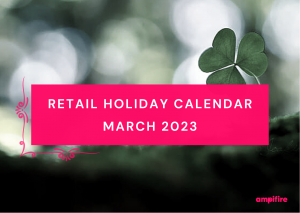
March 2025 Retail Calendar: Ecommerce Holiday Marketing & Content Opportunities
Maximize your March 2025 ecommerce success with our retail calendar, featuring key holiday marketing and content opportunities.

April 2025 Retail Calendar: Ecommerce Holiday Marketing & Content Opportunities
Discover the April 2025 Retail Holiday Calendar and learn how to leverage key events like Earth Day to boost sales…

January 2025 Retail Calendar: Ecommerce Holiday Marketing & Content Opportunities
Get a head start on the new year with our January 2025 retail holiday calendar and promotional strategy guide for…

E-commerce Content Calendar 2025: A Comprehensive Guide to Marketing Opportunities For Retailers
Check out our retail calendar for 2025 - it's packed with cool ideas for marketing campaigns to help online shops…

Vidalytics Features, Benefits, & Pricing: 2025’s New King of Video Marketing & Hosting?
Discover if Vidalytics is 2024's new king of video marketing and hosting with an in-depth look at its features, benefits,…



